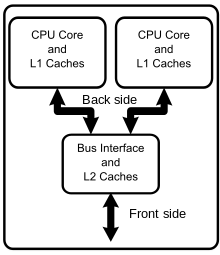
The front-side bus (FSB) is a computer communication interface (bus) that was often used in Intel-chip-based computers during the 1990s and 2000s. The EV6 bus served the same function for competing AMD CPUs. Both typically carry data between the central processing unit (CPU) and a memory controller hub, known as the northbridge.[1]
Depending on the implementation, some computers may also have a back-side bus that connects the CPU to the cache. This bus and the cache connected to it are faster than accessing the system memory (or RAM) via the front-side bus. The speed of the front side bus is often used as an important measure of the performance of a computer.
The original front-side bus architecture was replaced by HyperTransport, Intel QuickPath Interconnect, and Direct Media Interface, followed by Intel Ultra Path Interconnect and AMD's Infinity Fabric.
- ^ Scott Mueller (2003). Upgrading and repairing PCs (15th ed.). Que Publishing. p. 314. ISBN 978-0-7897-2974-3.